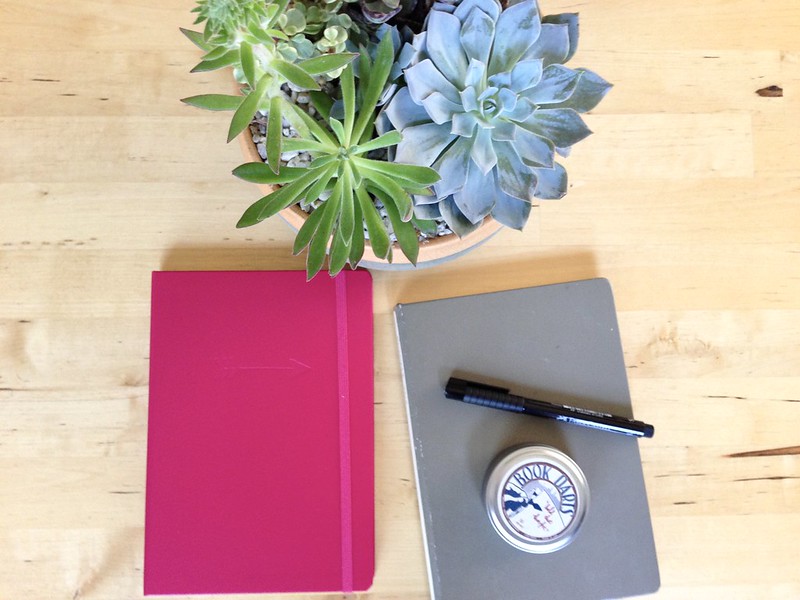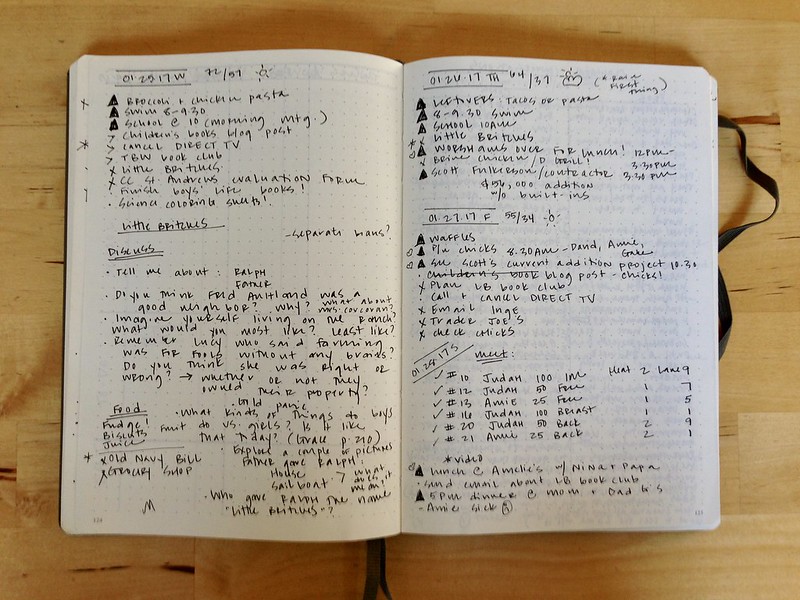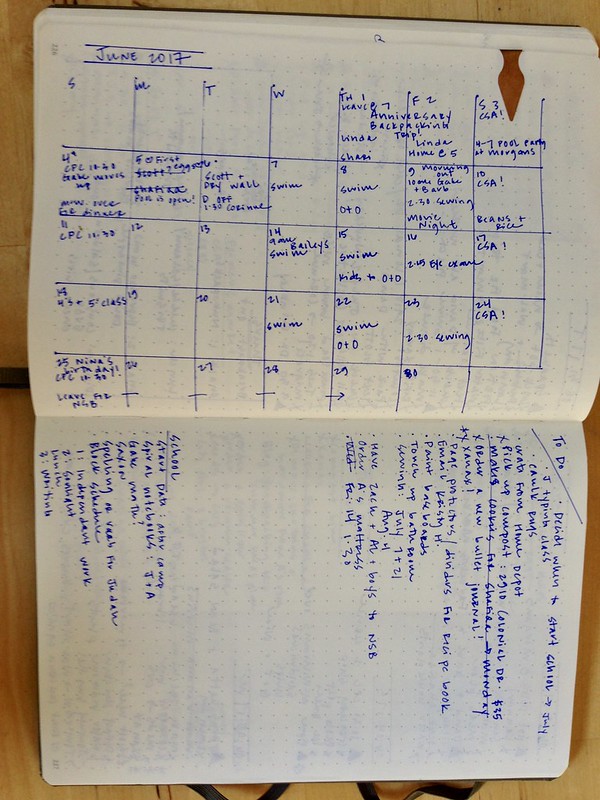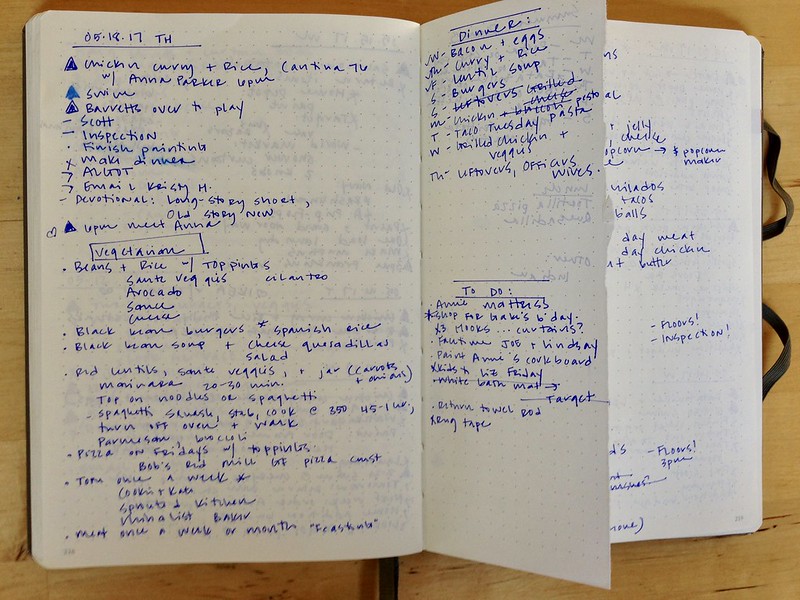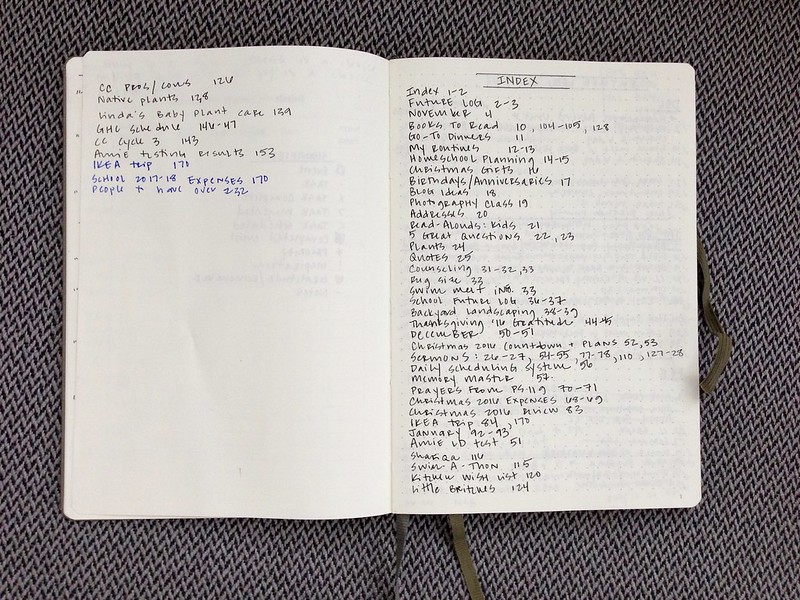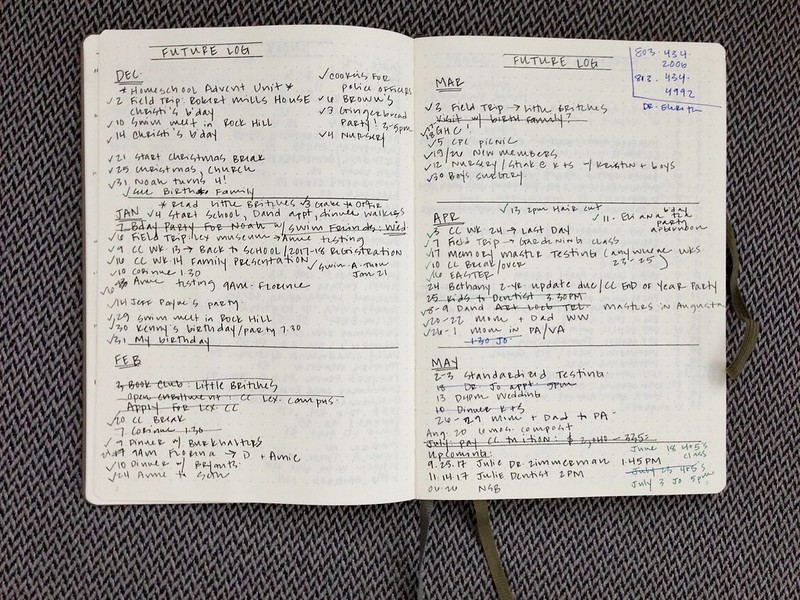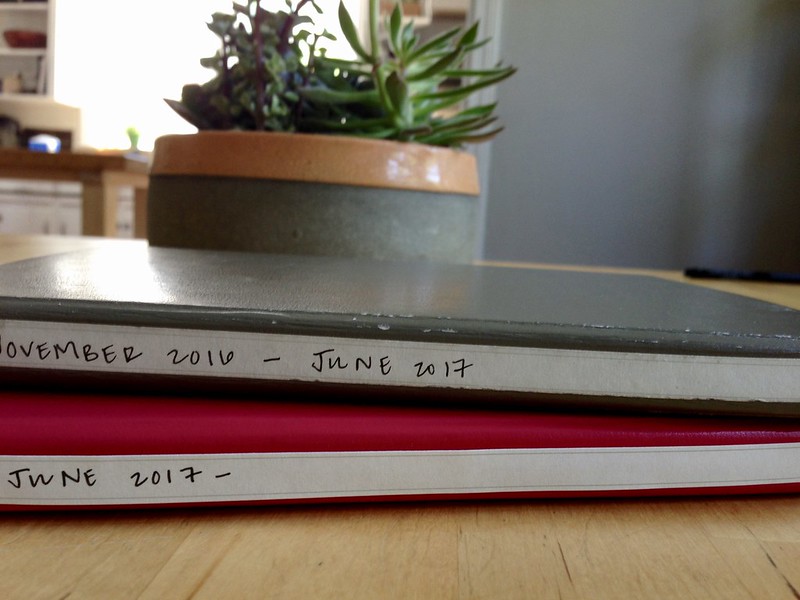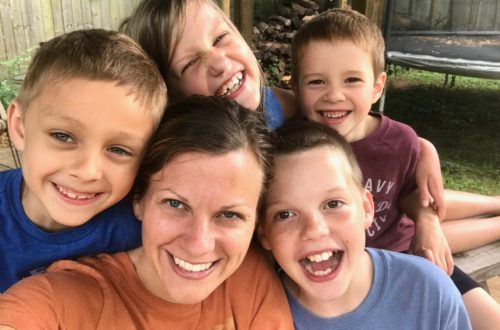a review of my first bullet journal.
Friday morning David took the kids on some errands and I spent a happy (quiet!) hour at the dining table starting my new bullet journal.
I did it! I finished my first bullet journal in its entirety!
I didn’t lose steam and shelve the thing halfway through the year as I’ve done with so many day-planners. I got my money’s worth!
Sorry. I read somewhere that exclamation points should be used very sparingly by blog-writers, and clearly I’ve broken that rule.
But I’m just really excited report that this system works for me
The bullet journal I use has 249 pages, and I used it for 7 months. I know, that’s pretty quick. My mother-in-law expects hers to last for an entire year, and David, who has the smallest handwriting on the face of the earth (says the person who painstakingly read his love letters in college), thinks his bullet journal will last 18 months.
All three of us use the same brand, which you can find here on Amazon, or, for a little more fun, here at Modern Mrs. Darcy.
We like it because the pages are already numbered and the dotted graph paper is great for ruling your monthly calendar. I also like the customizable label stickers.
I purchased my newest bullet journal from Modern Mrs. Darcy, because I love her blog and podcast so much, I want to support her work.
I posted about beginning to bullet journal back in January, so I’ll try not to repeat myself. All of the things I loved about it back then are true today. This post will be full of boring photos, but it’s the only way I know to show you what works for me.
Here’s a couple of new things I learned as I finished up my first notebook:
1. I don’t really track books I read in my bullet journal.
Does that surprise you? It does me. I tried a few different times, but I just don’t keep up with it.
I use the Goodreads website very faithfully now to track what I read, and it works great for me. Typically if I’m out and about and see a book I’d like to try, I’ll snap a photo of it with my phone. Every so often someone will mention a book in conversation and then I’ll jot it down there.
2. I enjoy the process of migrating tasks and setting up my monthly spread.
It takes a little more time than a ready-made planner, but it keeps my to-do list before me and let’s me purge things that have been finished or canceled. At the end of each month, I’ll pick a few quiet moments and sit at the dining table with a cup of hot tea and a ruler. I find it very soothing to draw up a new monthly spread and add events and tasks. Truly this takes no more than 30 minutes (well, unless you have a half dozen distractions).
I do not draw a cute little “migrate” arrow next to unfinished tasks unless I’ve literally re-written it for the next day. The act of writing it again helps me decide how important this task is, and whether it deserves a little star for “priority.”
Ok here’s a quick run down of my signifiers:
A triangle is an event; when the event is over I color in the arrow (yes, apparently dinner is an event in our house; I write what’s for dinner first thing under the date because my whole day feels smoother that way)
A dot is a task; I “x” through the dot when the task is completed
Side arrows mean “migrate” (as in, move the task to the following day or week)
Hearts are for fun memories
Stars are priority tasks
Pretty simple, right? You can really use whatever symbols you want.
3. Speaking of which, I like my bullet journal simple.
At the beginning I pinned so many adorable page spreads to a Pinterest board. I love people who doodle and turn even their to-do list into a work of art. I tried, I really did, but I am not one of those people. And I’m at peace with that. I started out checking the weather each morning and writing it in next do the date, but dropped that habit months ago.
As you can see from the photos, my pages are very plain-Jane. The plainer, the more likely I am to keep up with them. It’s just what works for me.
The genius is in the lists.
The genius is also in keeping my bullet journal close at hand (laying open on a bookcase at home during the day, in my bag when I go out), so that anything that pops into my head can be written down.
Years ago, a counselor actually recommended this habit of keeping a notebook with me (even at my bedside) since I struggle with anxiety. Little did she know that the bullet journal craze was about to sweep the nation!
4. I still love planning out my week by folding in a center page.
At the top is the dinner schedule, then underneath I began writing a “To do this week” list, which works well. I also write out a daily list, but I like picking and choosing from my weekly list. I found that it keeps me from feeling overwhelmed by tasks and needing to migrating unfinished tasks as often.
As you can see from the photo above, the back half of that center page was my grocery list, which I simply tear out with a straight edge and take the the store. I love this system.
Here’s a novel idea: when you’re waiting in line or have a few free minutes, instead of pulling out your phone, pull out your bullet journal! In this way I often have a head start on the grocery list and next week’s dinner ideas, which eases stress.
5. I don’t do homeschool scheduling or planning in my bullet journal.
This is something else I really tried. I looked up several blog posts and tried to copy other people’s systems, but it didn’t work. It felt too jumbled.
Now, I do keep running homeschool To-do list there, and will jot down ideas that pop into my head. But when it comes to actually planning out our days or record-keeping, I do those separately. I like a larger sheet of paper for homeschool brain-storming (like 8.5 x 11). Plus, as a friend commented, “I’m not sure I want our homeschool curriculum plans that entwined with my daily life.” I wholly agree.
6. I use very few running lists; I find that I didn’t really keep up with them.
Rather, I focus on my monthly and daily lists and when I write down important information (such as swim meet details), I add the page number that information occurs on to my Index in the front for easy reference. If I created an entire separate page for “Swim meets” it would probably mostly go to waste, especially since each meet information is quite different.
And there’s something very organic and “full of life” about scribbling sermon notes and book quotes and recipes under that day’s date. It makes the book more fun to read back over.
Does that make sense?
I guess something would warrant its own separate page if you have lots of information right from the get-go.
Want to know the few lists I did start in my brand new bullet journal?
– Friends we want to hang out/have over with this summer
– Things I need to do to be ready to start our new school year
– Blog post ideas
– And after all I just said, I simply couldn’t resist creating a new Book Recommendations list. It’s just nice to have.
7. Finally, I extended my Future Log to 12 months over 4 pages.
In my first bullet journal it was 6 months, and when I learned of a date beyond, like a dentist appointment, I was always crunching it into the corner. I do not stress about writing events in order in my Future Log, it’s more like a scratch box to add anything that will happen in that month. It’s always a bit messy. I’ll make it look all nice and organized when I sit with my monthly spread.
And that’s that!
It’s not a perfect system, of course. I still forget things.
But it’s the best system I’ve found for reducing how much I forget, for feeling organized, and for clearing the clutter from my head. I love knowing that pages aren’t going to waste.
I love the way it tracks our life.
David laughs because a couple of disputes as to when events occurred were solved by consulting my bullet journal. He says, “The bullet journal never lies.”
All of last December’s Christmas plans and activities and our baby chicks and our whole house addition process are encapsulated in my first now-battered notebook. It’s gratifying to skim back through and remember what we did and see how much we’ve accomplished.
